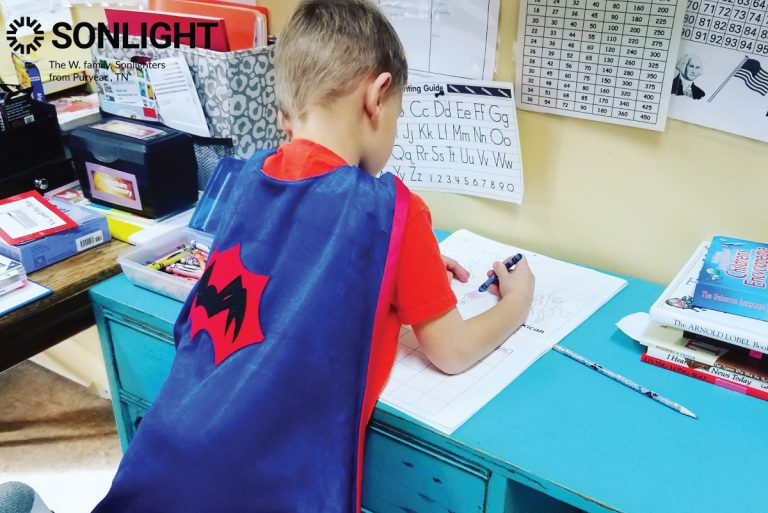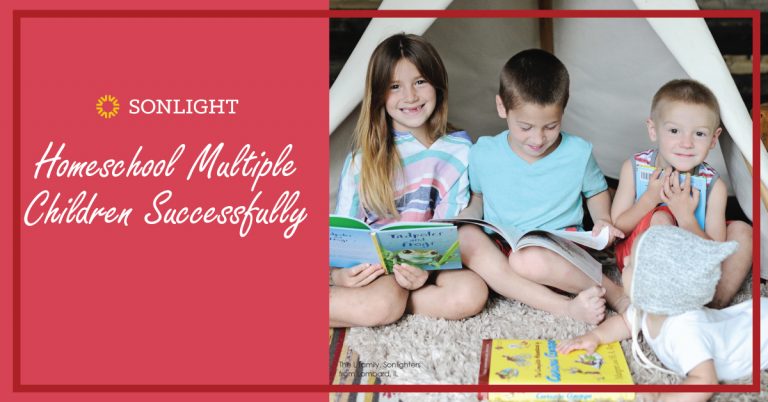
Anyone who has toddlers and preschoolers at home knows that homeschooling is a challenge with little ones underfoot. Most preschoolers don’t have the patience to wait a few minutes while you work on a math problem with your 12-year-old or to play with one toy until you reach the end of a chapter. You will likely find your preschooler interrupting every few minutes,or your toddler finding trouble every time you try to focus on teaching spelling.
Plan Ahead for Younger Children
After many years of homeschooling multiple children across wide age spans, I have learned tips to corral some of the chaos and keep us running more smoothly.
1. Create a Safe Play Area
Perhaps not all children were as adventure-seeking as some of mine, but I had a few escape artists over the years. By locking all exterior doors and windows and creating a safe play area (usually within eyesight) where I didn’t have to worry about their getting hurt, I didn’t have to spend as much time worrying about their physical safety. Also, because they could see and hear us, they were content to play longer.
I have seen families use baby gates, large indoor play areas, and pillows to create sectioned off areas for the young ones to play.
If you are homeschooling outdoors, large play areas, fencing, or even play pools (with water if you are very close by or dry pools filled with toys if you are not) can create a safe play area.
2. Plan Baby’s Schedule
We all know that babies don’t keep to a schedule. So planning for one might seem rather silly. But babies can have some predictable actions.
Check the baby’s diaper in between subjects so they are less likely to interrupt you while you are busy. Use a sling and feed them while reading aloud. Older children can help you turn the pages if you need both hands for a little bit. Try to predict the baby’s naptime so you can cover Table Subjects™ while the baby is sleeping.
3. Create Busy Bags and Toddler Trays
Busy bags are simply a series of small bags, each filled with one activity a young child will enjoy. Bags can contain almost any toy or educational project.
Toddler trays are simply food trays with larger activities that might not fit in a bag, such as games, sensory bins, and puzzles. The storage device does not matter.
I usually had on hand about one bag for each 10 minutes I wanted my children to keep busy. I would hand them one bag at a time, and they had to play with the activity on a special rug we had near our learning area. When they were done, they picked up the pieces, put them back in the bag, and handed it quietly to me. Then I would silently put it back into a basket we had nearby and silently hand a fresh busy bag. Our basket also had books, art supplies, and ready-to-make crafts.
If they didn’t pick up their pieces or were being too disruptive, they didn’t get a new activity. I tried to change up the bags every few days (cycling some in and out of the rotation and making new ones), to help keep them fresh. We did not allow them to play with the busy bags or toddler trays outside of school time, so as to maintain the novelty. These were school-only toys.
Sometimes, the activity would only last a minute or two. Other times, they would play for an hour or more. The choice of how long to use each activity was up to them.
Easy Busy Bag Activities
To get you started with busy bags or toddler trays, here are some simple items you might already have on hand.
- puzzles
- games
- lacing activities
- blocks
- paper with crayons, colored pencils, etc.
- coloring books with crayons
- colored paper and scissors
- shapes and shape mats
- play-dough
- fun books (or library books)
- letter shapes
- toy cars
- toy animals
- masking tape or scotch tape
- wooden craft sticks
- pipe cleaners
- stickers
4. Use Read-Alouds as Bedtime Stories
You might wish to read some Read-Alouds or History books from your curriculum after the little ones have gone to sleep for the night. This will give you extra bonding time with your older children, while still checking things off your schedule.
5. Let Family Help
Perhaps your mother would like to take the younger children for an hour a day while you get some work done. Or Aunt Sue would like to help out for a few hours every other weekend. Dad can even do math or science in his free time while you bathe the baby or play with the toddler (or vice versa). Don’t be afraid to ask for assistance.
6. Use the Buddy System
If you have a large family, the buddy system might help. Have any older children you are not currently working with play with or watch over one younger sibling while you help other children or get some reading done. By pairing children for short time periods, you can be more assured that each youngster is getting attention while you focus more fully on the homeschool task at hand.
Buddies can change from day to day or even from minute to minute. The same two children do not always need to be buddies. For example, a 7-year-old can watch a 3-year-old sister while you do spelling with the 9-year-old, and then the 9-year-old can take over little sister duty while you and the 7-year-old work on math.
Activities to Keep the Little Ones Busy
1. Finger Foods
I’ve found very young children who are hungry or thirsty are more likely to whine, cry, or want attention rather than ask for a snack. To keep them satisfied, I made sure to have a lot of healthy, protein-rich finger foods on hand.
2. Homemade Finger Paints
I would often buckle my nearly naked toddlers into a high chair and give them yogurts and puddings to use as finger paint. A washable drop cloth under the chair helped to contain much of the mess while giving them a safe place to explore the world of art.
3. Swimming Pools
When some of my children were younger, we lived in a house that had an enclosed, heated porch. This was the perfect place to pull out a little kiddie pool and let the younger children splash and play while I read a book or helped the older ones with homework around the edge of the pool. I was right there to keep an eye on them every moment, and I still was able to get schoolwork finished as well.
Very often, I would take a child messy from the high chair painting session and place them in the pool to help clean up the worst of the mess.
4. Educational Videos, Audiobooks, and Music
Over the years, we have amassed a huge collection of educational music and songs. Sonlight helped get us started with their Sing the Word CDs and Geography Songs. Their Lyrical Life science songs quickly became favorites as well. We used these songs to branch off into finding other great sources of educational songs about a wide variety of topics. We often put these on and dance and clean together as a family. It helps the little ones to feel more included, and it provides learning of things they will need to know in the future.
We don’t use audiobooks as much as some families do, but there are a lot of great books out on audio now. I use these with caution with my younger children, as they tend to tune them out more quickly than other forms of audio learning, but they still are great for quiet time.
Educational videos are also great. You can have the little ones watch along with what the older children are learning, or fall back on great videos such as Veggie Tales or LeapFrog Letter Factory to teach values or letters with minimal effort.
I have found that if we break up our day using video or music which includes the toddlers and preschoolers, I fill up their attention buckets. Then they are more cooperative when we go back to Couch Subjects™ and Table Subjects™.
5. Include the Little Ones
Young children truly need greater levels of attention and often hate feeling left out. So where possible, try to include them in your homeschool day. If you have older children sitting at a table doing math, give the toddler paper and let them pretend to do math with you. They can scribble or draw, but if they want an actual lesson to learn from, you can try teaching them to make straight lines, Ts, or Os.
I have found that for me, the hardest time to teach was when we had many children under age seven in the house. Those days were chaotic; however, I found that by planning ahead, I was able to corral the chaos and keep our homeschool on track.
Teaching multiple children at different ages can sometimes feel difficult to manage. Sonlight makes it easier by dividing our curriculum into two types of subjects: Couch Subjects™ and Table Subjects™.








